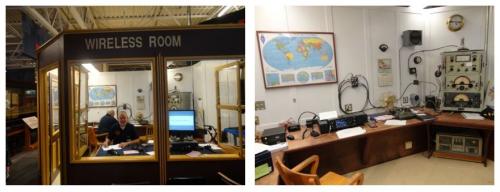The Wireless Room at the Maritime Museum of the Atlantic has been created by the Museum in Partnership with the Halifax Amateur Radio Club (HARC). This exhibit provides a visual demonstration of how ships communicated between each other and with shore stations after the advent of radio communications. Prior to the invention of radio, the primary method of communications at sea was by means of signaling flags.

Once radio became available, the losses at sea declined dramatically. Ships were not only able to communicate over long distances and during inclement weather but were also able to use radio direction finding to accurately determine their position.
The primary mode of communications for decades was “Morse Code”. Morse code employs a series of short signals or “dots” and longer signals or “dashes”. Each letter had its own unique code of dots and dashes. The coded message was then sent in a rapid sequence to the distant radio operator. This required some considerable skill to enable radio operator to send and receive messages at speeds of 30 words per minute or more. Morse code was the primary mode of radio communications at sea until satellite communications became available. Amateur radio operators throughout the world keep their skills at high levels, and still use Morse code, along with voice and digital modes to keep their communications skills polished. These skills are in constant use throughout the hobby and they also stand ready to put these skills to use during any emergency situation, especially when normal commercial communications fail.